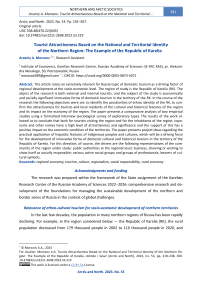Tourist Attractiveness Based on the National and Territorial Identity of the Northern Region: The Example of the Republic of Karelia
Автор: Morozov A.A.
Журнал: Arctic and North @arctic-and-north
Рубрика: Northern and arctic societies
Статья в выпуске: 53, 2023 года.
Бесплатный доступ
This article raises an extremely relevant for Russia topic of domestic tourism as a driving factor of regional development at the socio-economic level. The region of study is the Republic of Karelia (RK). The object of the research is both external and internal tourists, and the subject of the study is economically and socially significant innovative forms of domestic tourism in the territory of the RK. In the course of the research the following objectives were set: to identify the peculiarities of ethnic identity of the RK, to confirm the attractiveness for tourists and local residents of the cultural and historical features of the region and its impact on the economy of the region. The paper presents a comparative analysis of two empirical studies using a formalized interview (sociological survey of exploratory type). The results of the work allowed us to conclude that both for tourists visiting the region and for the inhabitants of the region, toponyms and other names have a high level of attractiveness and significance and the support of this has a positive impact on the economic condition of the territories. The paper presents project ideas regarding the practical application of linguistic features of indigenous peoples and cultures, which will be a driving force for the development of innovative forms of domestic cultural and historical tourism in the territory of the Republic of Karelia. For this direction, of course, the drivers are the following representatives of the community of the region under study: public authorities at the regional level; business, showing or wishing to show itself as socially responsible; various active social groups and groups of professionals; bearers of cultural symbols.
Regional economy, tourism, culture, regionalism, social responsibility, rural economy
Короткий адрес: https://sciup.org/148329497
IDR: 148329497 | УДК: 338.48(470.22)(045) | DOI: 10.37482/issn2221-2698.2023.53.219
Текст научной статьи Tourist Attractiveness Based on the National and Territorial Identity of the Northern Region: The Example of the Republic of Karelia
This work is licensed under a CC BY-SA License from 716 thousand people in 2002 in the whole of the RK to 609 thousand in 2020. 1 One of the reasons for this decline is not only the aging of the population, but also weak social infrastructure and lack of jobs. Now, thanks to state support, the situation with infrastructure in some rural settlements is changing, but the problem of employment remains relevant. One of the options for solving this issue could be the development of cultural and educational tourism in these territories. This is especially interesting considering that cultural codes are preserved more often in rural areas and, in addition to the economic growth of these territories, the preservation of the cultural diversity of Russia is expected. The local population often does not have finances or sufficient awareness of state support for small businesses in rural areas. In many large tourist sites, business comes from other regions. In RK, for example, it is often business from St. Petersburg and Moscow. This is not always a negative point, since such business fulfils the functions and adheres to the principles of social responsibility [1]. Further we will consider some concepts from this sphere and conduct a study of the opinions of tourists about whether they are interested in this type of tourism.
Ethnographic tourism is characterized as a type of tourism that solves the problem of meeting the needs of the spiritual spectrum of both individual travelers and organized tourist groups. Ethnographic tourism assumes acquaintance with culture and traditions of various ethnic groups, with a system of values, norms of behavior and principles on which relations between people in the state are built. Since one of the most important features of the Russian population is multinationality, the global development of the sphere of domestic tourism will make it possible to introduce the peoples of our country to each other, strengthening ties between representatives of different ethnic groups at the horizontal level, which will, in turn, contribute to enhancing the sense of unity the entire multinational population of Russia. Considering the fact that the main ideological and practical tasks in the field of interethnic relations are the preservation and strengthening of Russia as a single and indivisible state, tourism in this area can fully play an invaluable and vital role. Tourism is a type of human activity that is closely related to the achievement of such positive results for society as national harmony and peaceful existence [2].
To give a qualitative definition of the concept of ethnic tourism, let us turn to the position of the domestic researcher of interethnic relationships and ethnic groups N.A. Berkovich. He believed that ethnic tourism differs significantly from other types of tourism primarily in its focus on satisfying the needs of individuals and groups for ethnicity and ethnosocialization. He noted that this type of tourism is more aimed at allowing tourists to “touch” the relict, anachronistic past, the diachronic and intergenerational sources of archetypicality, behavioral stereotypes and unique mentality. Thanks to ethnic tourism, modern civilization has a unique opportunity to uncover lost or half-forgotten semiotic, symbolic codes of the meanings of ethnicity, to study and comprehend its genetic and cultural codes, genealogy, to reconstruct historical memory and, as a result, to form its own ethnonational identity [3].
Ethnic tourism is an immersion in the culture and history of a people or ethnic group with the aim of getting to know and studying the otherness of its cultural and historical characteristics and traditions, as well as the perception of specific unique features of culture and way of life. Thanks to this, a system of images and ideas about the life and culture of this people is formed in the researcher’s mind, as well as an awareness of the meanings of their most important identifications: religious, ethnic and civil. According to O.V. Chistyakov, thanks to this understanding of tourism, we can talk about the presence of the diversity of culture in the modern world with the remaining uniqueness of the religious and ethnic life of various peoples and ethnic groups, even despite the modern trend towards the globalization of the unification of cultures [4].
It should be noted that tourism is a separate social institution with its own stratification and infrastructure, which performs several functions in the dialogue of cultures:
-
• promotes the establishment and expansion of interreligious, interethnic and social communications on a global scale;
-
• contributes to the mutual value enrichment of different peoples and ethnic groups;
-
• economically and socially supports the territory of indigenous peoples and other rural areas.
In the context of the trend towards globalization, the modern world initiates and even assumes the openness of ethnic and subethnic groups in relation to each other, which promotes the mutual exchange of scientific knowledge and ideas for further development, cultural artifacts, secular and religious ideas and achievements in the information and technological spheres of human activity. Thanks to tourism, travelers can get acquainted with the political, economic, religious and other realities of different territories even in the conditions of post-modernization of society. It should be noted that mass media structures are responsible for the created images of societies receiving tourists [5].
Every year the number of regions taking an active part in state programs aimed at developing the tourism industry increases, both in terms of increasing the attractiveness of their region for various types of tourism, and encouraging companies involved in organizing domestic and foreign tourism.
It is interesting to note that ethnographic tourism is an independent type of tourism, which also performs a number of important social functions:
-
• supporting the economy of rural areas;
-
• preservation of cultural elements of different peoples;
-
• ensuring the preservation of historical and ecological diversity;
-
• strengthening regional self-identification;
-
• increasing the intellectual and cultural level of the population of certain territories;
-
• prevention of interethnic relations;
-
• acquaintance with local cultures of tourists;
-
• revival of traditions, rituals, local cuisine and crafts.
Being engaged in organizing tourism at this level, it is not enough to simply carry out a selection of group and individual tours, which includes visits to ethno-recreation sites. Ethnic tourism is a unique type of tourism that always carries a cultural and educational load; it is, in fact, a part or element of mass or individual tourism, which is often considered one of the most attractive in the region, but not the only one. That is why a tourism product of this type should be characterized primarily by complexity; for example, a tour package may consist of the following services:
-
• movement through an ethnic zone;
-
• accommodation in significant historical places (for example, accommodation of a tour group in a Karelian settlement);
-
• lunch consisting of dishes traditional for this ethnic group in the past (for example, open pies with berries, which have been the traditional food of Karelians for many centuries);
-
• folklore events (for example, visiting the agricultural festival “Ukko Bowl”, etc.).
All these elements are somehow involved in the economic turnover.
In addition, attention should be paid to the possibility of forming tours based on the needs and interests of tourists. For this purpose, tour operators often include in tours not only different places of visit, but also various parts of ethnic and sports tours: ecological and ethnographic, nostalgic, hiking and horseback riding, etc. [6]
In 2020, domestic tourism declined due to the COVID-19 pandemic. But already in 2021, 56 million people travelled within the country, which indicates that domestic tourism volumes have been recovered by almost 90% compared to 2019.
Now relevant researchers in the field of ethno-cultural tourism are Maslennikova E.G. (et al.) [7], Vintaikina E.V. [8], Dashkova E.V. [9], Safarova T.R. [10], Lysikova O.V. [11] and others. In the Republic of Karelia, issues of ethno-cultural development from the perspective of regional economic development are studied at the Institute of Economics of the Karelian Scientific Center of the Russian Academy of Sciences by various authors: Morozova T.V., Belaya R.V., Vasilyeva A.V., Morozov A.A. [12], Kondratyeva S.V. [13].
Since the modern information society is in constant and continuous development, the process of globalization is becoming more and more active, due to which a number of economic processes also receive an additional impetus for development. However, it should be noted that in the field of national culture and history, globalization processes often cause crises of national consciousness and identity. One such example is the escalating confrontation between various theories of regionalization and globalization, that is, the development of new regionalism [14].
In the last 15 years, the vector of development of the Republic of Karelia has begun to turn towards tourism. This is often reported in the headlines of scientific and media articles. Many visitors associate Karelia with tourism and trout farming. The extraction of timber, stone and minerals is relegated to another plan.
Traditionally, the tourism potential of the Republic of Karelia is associated with the famous large sites located on Kizhi Island, Valaam Island, and Ruskeala quarry. Over the last decade, many local museums and other interesting venues were opened (Bastion, Zaonezhskiy museums, etc.). There was a transformation of the organizational and legal status of these objects according to the “outsider” model, which led to the irreversible withdrawal of the economic benefits obtained as a result outside the region. This problem is as relevant as it was in the 2000s. Representatives of Karelian business are no longer the main managers and owners of many large companies in Karelia.
There are already existing achievements of scientists in the field of development of cultural and historical destinations in the Republic of Karelia. Over the past twenty years, various issues related to the development of tourism in the border municipal areas of the RK have been studied. There is an information base that includes elements of regional and municipal statistics, data from republican websites, sociological studies and various materials from scientific and practical conferences.
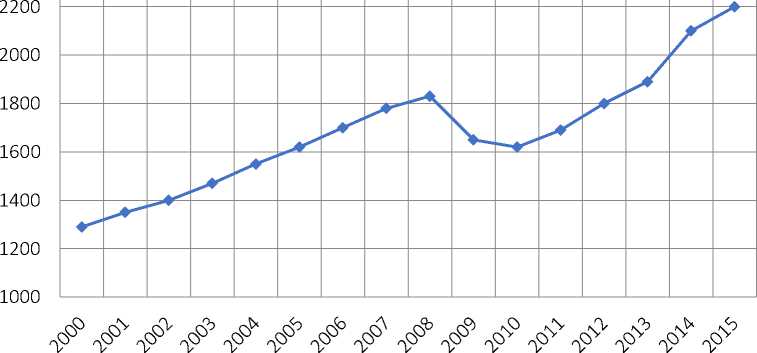
Fig. 1. Approximate number of people who visited the Republic of Karelia (thousand people) 2.
According to the data in Fig. 1, there was no decline in the number of people visited Karelia from 2010 to 2015. In the author’s opinion, there was no decline until 2023. An exception may be 2020, but it is not as significant as it was in 2009–2011. Based on the author’s personal interviews with representatives of the tourism business, the pandemic year left its mark on business, but not critical. Gastronomic facilities suffered the most, many of them were closed down.
-
2 Data on tourism development in Karelia. URL: http://gov.karelia.ru (accessed 20 January 2023).

Fig. 2. Number of organized tourists in the Republic of Karelia (thousand people) 3.
Fig. 2 shows the number of organized tourists for 2006–2021. This indicator is easier to calculate and the data are freely available. The figure shows a sharp decline in organized tourists in 2011 due to economic and political crises. In 2013, the number of organized tourists in Karelia was about 600 thousand people and this exceeded the pre-crisis level of 2008. The flow to the main sites (for example, to Kizhi Island) increased 4. During the pandemic period, the development and support of domestic tourism was strong, and the number of tourists grew. Data for 2022 are still in the formation stage, but it can be assumed that the number will not decrease. Karelia has lost foreign tourists, but the bulk of them have always been from St. Petersburg and Moscow. Taking into account the development of rail buses, air service and other means of transport in 2021-2022, the growth of infrastructure at organized sites has increased significantly. The vector of tourism development in the Republic of Karelia as early as 2020 was redirected sharply towards domestic tourism.
Karelia also attracts both organized and independent tourists with its wild nature. It is worth noting that the number of tourists of the latter type is estimated with great variation. That is why networks of guest houses have now become so widespread and developed, regardless of their location, that is, this applies to both networks of guest houses in remote places and in close proximity to rural settlements and towns. Various accommodation options are also being developed within national parks and reserves. At the same time, the problem of poor development of cities and villages, namely the low level of development of their infrastructure, is quite acute, as a result of which the interest of tourists in the region is decreasing. This may be another reason for the development of “wild” tourism, and this, in turn, has a significant impact on the environmental situation in the region. This question is now becoming more relevant due to the many lakes in the region. Most of these lakes are domestic for local residents; they “feed” cities such as St. Petersburg, Novgorod, etc. Pollution of coastal zones is growing significantly.
In the current circumstances, the progressive development of various forms of ethnotourism and cultural tourism [15] of villages and towns in the region can become a force for their economic development, increasing the multifunctional effect of tourism. Tourists who come to Karelia and neighboring territories are interested in the names of towns, villages, and geographical objects. For tourists, this is a feature of the White Sea-Baltic cultural region. The development of forms of national-territorial identity will increase the level of its uniqueness, complementing the Russian tourism sector with important economic assets, which can contribute to the favorable position of Karelia among other, especially more southern, regions of Russia. Social responsibility of business plays an important role in this matter. New forms of business support based on nationalterritorial characteristics involve the local population in the work, thanks to which elements of the real culture of certain places can be preserved longer.
The concept of “indigenous cultures/peoples of Karelia”, used by the author in this article, means the cultures of the Vepsians, Karelians, Pomors, Finns, Pudozhans and Zaonezhans. From the perspective of cultural studies, there are many similar or identical cultural elements among the indigenous cultures (with the exception of Sami) in the White Sea-Baltic region, for this reason the author evaluates this region as one cultural space with a slight difference in cultures, supporting the ideas of Finno-Ugric and Baltic roots, regardless of language and nationality. Besides, the author excludes formal statistical data regarding the national composition due to the fact that a fairly large number of people are formally recorded as Russian (from the author’s personal example).
Empirical research
In 2016, the author had already written material on the topic of ethno-cultural tourism based on toponymy and ethno-futurism [16]: an attempt to conduct a sociological research of the reconnaissance type was made. Certain conclusions were made, which the author of this article will discuss below. The study itself was carried out in 2015, and the author conducted a similar survey in 2022 with a similar “tourist-local” layout with the addition of some new questions.
As part of this study, an exploratory type empirical study was conducted by the author in 2015 5, which included an online questionnaire survey. The study involved 101 participants, among whom 45 were residents of the Republic of Karelia, 35 had visited the RK and 21 had never been there.
In 2023, the author conducted a similar study with additional questions. It also involved 101 people, among whom 48 were residents of Karelia, 33 had visited it, and 20 had never been there.

rarely (1-2 times a year)
2-3 times a year
often (more than 5 times a year)
-
■ was a long time ago
haven't been yet
Fig. 3. Frequency of visits to Karelia by external and internal tourists (share of answers, %) 6.
-
Fig. 3 shows the share of responses of tourists travelling to Karelia or having such an intention. In the 2015 study, the author received only 60 responses, in the current one — 101. Comparing in relative terms, it can be noted that people have started travelling more often. More people have become aware of Karelia, and if in 2015, 41% of respondents answered “rarely, 1-2 times a year”, then in 2022, this is already 28%. Similarly, the answer “have not been there yet”: 37% for 2015 and 20% for 2022. The indicator “often, more than 5 times a year” increased insignificantly.
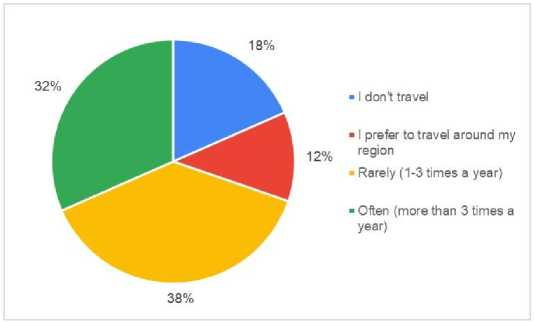
Fig. 4. Frequency of tourists’ visits to other regions of the North-Western and Central Federal District of the Russian Federation (share of answers, %) 7.
Based on the results presented in Fig. 3 and 4, Karelia has a great chance to attract tourists who have already been there or are planning to visit. Comparing data for 2015 and 2022, one can see that the frequency of the answer “often, more than 3 times a year” has increased significantly, almost doubling.
The problem related to pricing remains. Many travel companies focus on the incomes of richer strata of the population, as well as the incomes of residents of St. Petersburg and Moscow,
without taking into account the level of wages of the local population. It is worth noting here: the question is not even about the income of the residents of Petrozavodsk, but of local groups, i.e. villages, small towns. As a result, some of the local tourists are forced to look for other more affordable ways of leisure, and the region narrows the segment of domestic tourism. “Wild” tourism continues to develop.

Fig. 5. Attitude of tourists to toponyms (names) of the Republic of Karelia (share of answers, %) 8.
As can be seen from the research results, for the majority of tourists and locals, the names of geographical places are attractive. The 2015 questionnaire included an “other” column, where people offered various options reflecting predominantly positive emotions, and only one person expressed a neutral position. Most people define toponyms as interesting, creating flavor, features of the region.
In the current questionnaire, it was decided to abandon this question. In comparison, the situation for 2015 and 2022 has not changed, the absolute ratio is almost the same.
One of the interesting options for development in the field of tourist attraction based on toponyms could be the introduction of QR codes near various settlements with a rich history. When asked in a 2015 survey regarding such an initiative, about 90% of respondents answered positively.
In the 2022 questionnaire, 84% of respondents responded positively. In the author’s opinion, this is due to the development of the information society; before visiting a particular geographical place, people independently find information in advance. On the other hand, it could be a coincidence.
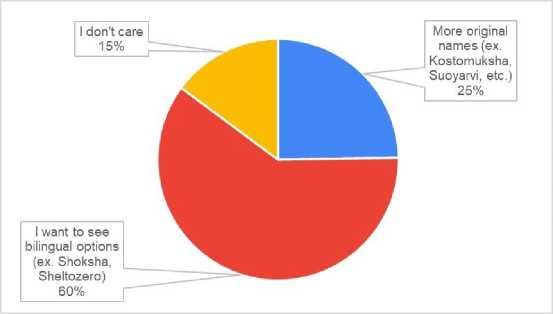
Fig. 6. Attractiveness of variability of names of settlements and other places (cultural and geological) (share of answers, %) 9.
The figure above shows the respondents’ answers about the type of toponyms they would like to see. The results of the 2015 questionnaire showed that slightly more than half of those surveyed would like to see bilingual names on roadside signs of settlements and in geographical names (e.g. Sheltozero —Šoutjärv), and only a quarter responded that they would like to see the original name (e.g. Sortavala, Kondopoga ).
In the 2022 questionnaire, there are slightly more responses about bilingual names. According to the results of the survey, we can confirm that for the majority of respondents in both questionnaires, Baltic-Finnish names are attractive, and people would like to see bilingual signs. In addition, there is a problem that is repeatedly mentioned by toponymists from ILLH KarRC RAS — road workers who use the atlas of toponyms and hydronyms are often mistaken due to inaccuracies in these atlases. ILLH KarRC has been working on this problem for a long time and despite the fact that the issue is not so complicated, contacts with officials are very difficult and the issue is still relevant [17]. One of the solutions to this problem could be such bilingual roadside signs on the main highways of Karelia.
A similar format (bilingual signs) can arouse deeper interest in the stories of certain areas and expand tourist routes. It is especially important to increase interest and appeal among the younger generation of local residents. Unfortunately, there is a tendency to reduce and filter the information presented in schools and non-core universities, and this includes elements of local history and culture. Science does not stand still, but the teaching system often does not include the modern developments of scientists. The most popular element of teaching local history is the study of its flora and fauna and the Soviet period in the history of Karelia. However, the territory itself is more than 1000 years old.
The Republic of Karelia is different in its characteristics. The north and the south have their own historical and geographical features. Tourism should be developed in different directions, in a union of natural, historical and cultural elements.
An important issue is bilingualism on signs in the city of Petrozavodsk during the Soviet period. Until the 1980s, despite the decline in the share of indigenous peoples in the national-ethnic composition, this was the norm. Many visitors of the city noted that they liked it, it gave a certain flavor to the area. In the 1990s, this cultural element of the urban environment was important due to the wide opening of borders. People from other countries began to visit Petrozavodsk more often. For Finns, for example, it was a very important element. Bilingual names attracted not only foreign neighbors, but also tourists from Russia.

Fig. 7. Attractiveness of Finnish names/signs in Petrozavodsk of the Soviet and late Soviet period (share of answers, %) 10.
Fig. 7 presents answers about signs that could still be found on the streets of Petrozavodsk during the perestroika period. According to the results of the comparative analysis of the two arrays, we see an insignificant difference in the answers (+\-3%).
Since 2020, bilingual signs with street names and house numbers began to be installed in Petrozavodsk. The design of the signs was chosen to be almost the same as in Soviet times.
In addition to this question, the current 2022 questionnaire contained two questions that were not in the 2015 questionnaire. The first of them was “Several years ago, signs with street names in two languages appeared in Petrozavodsk, how do you feel about this?”
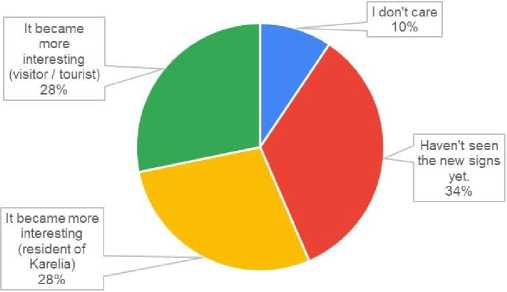
Fig. 8. Attractiveness of bilingual names/signs in Petrozavodsk in modern times (share of answers, %) 11.
As can be seen from Fig. 8, this practice is positively assessed by both tourists and local residents. Indeed, when you come to another city, you can “touch” a piece of local culture, these are
-
10 Source: compiled by the author.
-
11 Source: compiled by the author.
positive aspects. This question was with the “other” item, where people criticized the design of signs, the choice of the Karelian language dialect and other points. However, there were very few such responses. Despite the fact that the historical parts of the city are almost completely equipped with such signs, the percentage of people who have not seen them remains high. In the author’s opinion, these signs are well made: white letters on a blue background are clearly visible.
Another additional question in the 2022 questionnaire was the respondents’ opinion regarding the need for such signs in other major cities of the Republic of Karelia. The study showed that 61% of respondents consider this necessary, but only for large cities, such as Kondopoga, Sortavala, Belomorsk, Olonets, Kostomuksha; 21% of respondents answered that they do not care.
In the current situation, despite the introduction of signs, the presence of a department at Petrozavodsk State University, a school and a kindergarten, the overall situation with bilingualism is in poor state. Indigenous cultures are perceived as somewhat archaic. There is practically no contemporary art and music left.
This survey was carried out in order to study the respondents’ opinions about what exactly they mean by the concept of “Karelian identity of the region”. As a result of the survey, different answers were received, which were subsequently combined into the following blocks:
-
• natural and geographical features: animals, lakes, swamps, forests, waterfalls, etc.;
-
• cultural features: language (multilingualism), traditions and customs, folk cuisine, mentality, architecture, bathhouse, national character of each nationality, folklore, history, petroglyphs, unique culture of the region; the presence of Karelian, as well as Karelian-Finno-Vepsian elements in the modern way of life, etc.;
-
• social and emotional-psychological characteristics: the level of self-awareness of the population, the uniqueness of the region, the similarity of Karelia with other regions of the Russian Federation, the community of the population, pride in the residents, the desire to help the development of their region, etc.
Compared to the responses in 2015, in the current study, people increasingly spoke about the preservation of the language, commitment to culture and local traditions, local people’s awareness of their roots, and identification of people with the indigenous population of this region.
In addition to the study of bilingualism and toponyms, a very important issue in the development of culture remains its elements: art, music, literature.
40%

-
■ Modernized culture with traditional elements (for example, modern electronic or rock music with elements of the Karelian language)
-
■ Traditional culture, without strong intervention of modem elements
-
■ Both options
* Not interested in ethno-cultural elements
Fig. 9. Attractiveness of traditional forms of culture among tourists (share of answers, %) 12.
Fig. 9 presents answers to the question “What do you like most of all?” regarding the form of culture. Compared to 2015, the current questionnaire contains more answers about ethno-futuristic elements and about the same percentage regarding traditional forms. This result is understandable: visitors prefer to perceive traditional culture more. However, there can be no development without modern elements of expression. A region that supports only traditional values, rejecting modern forms, will stand still in terms of intellectual and cultural development.
When studying models of ethno-futurism, it is worth noting that one of the difficult issues is defining the framework between the traditional, intermediate and modern stages in the expression of cultural elements (art, music, literature).
The situation with literature in national languages in Karelia is not so bad. Various journals, newspapers, and books are often published. The situation is worse in art and music. Art has long ago become integrated, elements of indigenous cultures are hidden under a common globalization “mask”. In the field of fine arts of Karelia, there are still representatives engaged in traditional crafts. However, contemporary art with a national flavor is receding into the background. There are not many new projects in the musical sphere in the Republic of Karelia. Young authors more often use English in their works, which reduces the historical and cultural uniqueness of Karelia. In the field of fine arts, artists also rarely use these elements. Over the past 10 years, interest among designers has actively increased. However, this new ethno-futuristic design has become a kind of peculiarity rather than an everyday occurrence. Simply making an interior design, for example, in the Karelian style has become financially difficult for ordinary citizens. There are representatives of the cultural sphere who do not live in Karelia, but are involved in the development of Karelian, Finnish and Vepsian cultures. A lot of such representatives live in St. Petersburg.
The survey included a question about understanding ethno-futurism and about Karelian artists, writers, and musicians in this area. About 80% of respondents do not know any. According to the author, this is primarily due to the fact that people are not familiar with the concept of “ethno-futurism”. Indeed, when asked the corresponding question, 76% answered that they did
NORTHERN AND ARCTIC SOCIETIES
Arseniy A. Morozov. Tourist Attractiveness Based on the National and Territorial … not know. Respondents listed some ethno-futurists: Ondrei, Ilmu, Myllarit (not relevant), Arto Rinne and Sattuma, Yarga sound system, as well as some artists who have these elements.
In order to develop the sphere of cultural tourism, it is necessary to support young talented artists, designers, musicians, writers. It is advisable to highlight the fact that this support can be provided by both state agencies and private foundations and business representatives. Thanks to the development of the cultural layer of ethno-futurists, the tourism sector in Karelia will receive a new impetus for development. More specifically, this can be expressed in the following aspects:
-
• revival and popularization of history;
-
• revival of cultural traditions;
-
• revival of the language of various Karelian nationalities, its use in modern conditions.
Conclusion
The development of a region is usually a long process, but the time and effort put into it will have a positive effect in the future. The main goal is to preserve and transmit information about the diverse forms of authentic indigenous cultures of the region and to introduce new forms based on these elements.
The tourism sector is one of the fastest growing in Karelia. State authorities and business should focus on how the region can be developed so that it retains its originality, different from other regions. People always like to come to other places and see other cultures.
Karelia shows how many peoples, including those who are quite similar culturally at certain stages of history, can live together, develop a common economy, culture, architecture, etc. without forgetting their individuality. An example is Zaonezhye, where 3 large nationalities coexist: Vepsians, Karelians and Russian settlers from Novgorod, Pskov and the Vladimir-Suzdal land. However, the cultural elements of these peoples are quite similar due to historical ties. Much of the history of the influence of the Baltic-Finnish peoples on the common, mixed culture has already been lost, and the history of the region is poorly transmitted to the younger generation of the Republic and neighboring regions.
Brief results of comparative analysis can be seen in Table 1. Compared to 2015, respondents often give more formulated answers to the question of understanding what the ethnic identity of the region and ethno-futurism are.
Table 1
Indicators of the survey results for 2015 and 2021 on the main questions 13
|
Questions |
The most important indicators for 2015 |
The most important indicators for 2022 |
Result |
|
Frequency of travelling in NWFD and CFD of the Russian Federation (Fig. 4) |
51% of answers -rarely, 18% of answers -often. |
38% of answers -rarely, 32% of answers -often. |
Respondents began to travel within the country more often. |
|
Knowledge about the |
Encountered |
Encountered |
Increased direct |
|
traditions and culture of the peoples of Karelia |
personally - 31%. Not familiar — 14%. |
personally - 48%. Not familiar — 4%. |
contact with elements of indigenous cultures. Increased interest in indigenous cultures. |
|
Frequency of travelling in Karelia (Fig. 3) |
Have not been to Karelia — 48%. Travel often — 10%. Visit 2–3 times a year — 7%. |
Have not been to Karelia — 19%. Travel often — 17%. Visit 2–3 times a year — 19%. |
Increasing tourist flow to the Republic of Karelia. |
|
Attractiveness of toponyms and hydronyms in Karelia (Fig. 5) |
Attracts tourists — 42%. |
Attracts tourists — 50%. |
Attractiveness has increased. The responses of local residents remained at the same level. |
|
Attractiveness of the form of using toponyms on roadside signs and other places (bilingual, original Russified, etc.; Fig. 6) |
Bilingual — 59%. Original and Russified names — 22%. |
Bilingual — 60%. Original and Russified names — 25%. |
There is almost no difference, but the option with bilingual signs still prevails. |
|
Tourists’ interest in the offered ethno-cultural services (ethno-futuristic, traditional; Fig. 9) |
Modern (ethno-futuristic) culture with traditional elements — 24%. |
Modern (ethno-futuristic) culture with traditional elements — 35%. |
Forms of expression using modern instruments have become of greater interest to tourists. |
Based on the survey results, it can be argued that both visitors and tourists liked elements of indigenous languages in the urban environment of the late Soviet era. After the appearance of such signs in Karelian and Russian in modern times, people also note increased interest, including among tourists. However, it is worth noting that the Karelian language is the only indigenous language of Russia (among 22 republics) that is not the state language in its native Republic 14. People travelling through Prionezhye always pay attention to the signs with toponyms Shoksha, Vehruchei, Sheltozero.
As a result of the study, data was obtained that allows drawing conclusions about the high attractiveness and importance of toponyms and hydronyms for residents of the region and tourists. The multiplicative effect of the introduction of cultural elements of the indigenous peoples of the Republic of Karelia is manifested in the development of the national and regional identity of the community. It is an important component of the model of national identity of Russian society in general and the northern territories in particular [16].
According to the results of the study, it can be seen that tourists started travelling more often both to Karelia and to the regions of the North-West. People became more attracted by this national-cultural diversity. People more often want to see local dishes on the menus of gastronomic facilities, often in two languages or in the local language. Slightly more people have become interested in various modern types of cultural expressions with ethnic elements. All this is already having a positive effect on the economic situation of the region. The results of this study only confirmed this, which means that the main actors should pay more attention to this and support rural initiatives.
In terms of positive factors that can affect the social and economic development of Karelia, the development of historical and cultural tourism based on ethno-futurism and toponyms can become one of the most important directions for this process. The main drivers of development in this aspect include various representatives of the local community: regional and municipal authorities, socially responsible businesses, and most importantly, active professional and social groups, bearers of cultural symbols. Regional authorities should consider cultural initiatives more carefully. More attention should be paid to ethno-futuristic projects.
It is required to develop innovative forms of regional identity in their modern form, thanks to which there will be development of the regional community as a whole, as well as economic and social development of rural areas. An important element is the strengthening of interethnic ties, which will contribute to the development of Russian society as a whole.
Список литературы Tourist Attractiveness Based on the National and Territorial Identity of the Northern Region: The Example of the Republic of Karelia
- Vazhenina I.S., Vazhenin S.G. Konkurentsiya territoriy za budushchee: osobennosti zarozhdeniya i stanovleniya [Competition of Territories for the Future: Features of Origin and Formation]. Federal-izm [Federalism], 2022, vol. 27, no. 4 (108), pp. 21–36. DOI: 10.21686/2073-1051-2022-4-21-36
- Trofimov E.N. Razvitie etnograficheskogo turizma v Rossii [The Development of Ethnographic Tour-ism in Russia]. Vestnik RMAT [Vestnik of RIAT], 2013, no. 4, pp. 3–13.
- Berkovich N.A. Etnicheskiy turizm — kul'turnye smysly puteshestviy i rekonstruktsiya istoricheskoy pamyati [Ethnic Tourism — Cultural Significance of Travel and Reconstruction of Historical Memory]. Industriya turizma: vozmozhnosti, prioritety, problemy i perspektivy: sb. nauch. statey i materialov Mezhdunarodnoy nauchno-prakticheskoy konferentsii [Tourism Industry: Opportunities, Priorities, Challenges and Prospects. Proc. Intern. Sci.-Pract. Conf.]. Moscow, MATHC Publ., 2011, pp. 6–9.
- Chistyakova O.V. Etnicheskiy turizm v kontekste mnogoobraziya kul'tur sovremennogo mira [Ethnic Tourism in the Context of Cultural Diversity of Contemporaneity]. Vestnik Voronezhskogo gosudar-stvennogo universiteta. Seriya: Filosofiya [Proceedings of Voronezh State University. Series: Philos-ophy], 2021, no. 2 (40), pp. 118–127.
- Chistyakov D. The Influence of Mass Media on Consumer Culture: Religious Tourism. Logos, 2020, no. 104, pp. 140–147. DOI: 10.24101/logos.2020.58
- Bazilevich S.V., Lipkina E.D., Malygina M.V. Organizatsionnye aspekty i napravleniya razvitiya et-nicheskogo turizma v Respublike Krym [Organizational Aspects and Directions of Development of Ethnic Tourism in the Republic of Crimea]. TsITISE [CITISE], 2022, no. 1 (31), pp. 451–466. DOI: 10.15350/2409-7616.2022.1.39
- Maslennikova E.G., Litvinova E.V., Danilova V.A., Silaeva A.A., Gozalova E.A. Issledovanie etnokul'turnogo vnutrennego i vneshnego turizma Kaliningradskoy oblasti [Research of Ethnocul-tural Internal and External Tourism of the Kaliningrad Region]. Ekonomika i predprinimatel'stvo [Economy and Entrepreneurship], 2020, no. 12 (125), pp. 436–441. DOI: 10.34925/EIP.2021.125.12.086
- Vintaykina E.V., Vetkina S.N. Razvitie etnokul'turnogo turizma kak sposob smyagcheniya mezh-natsional'nykh protivorechiy [Development of Ethno-Cultural Tourism as a Way to Mitigate Inter-ethnic Contradictions]. Obrazovanie. Nauka. Nauchnye kadry [Education. Science. Scientific Person-nel], 2021, no. 1, pp. 106–107. DOI: 10.24411/2073-3305-2021-1-106-107
- Dashkova E.V. Praktiki etnokul'turnogo turizma: ekzistentsional'nye aspekty [Ethnocultural Tourism Practices: Existentional Aspects]. Vestnik Yuzhno-Rossiyskogo gosudarstvennogo tekhnicheskogo universiteta (NPI). Seriya: Sotsial'no-ekonomicheskie nauki [Bulletin of the South-Russian State Technical University (NPI). Series: Socio-Economic Sciences], 2021, vol. 14, no. 6, pp. 228–236. DOI: 10.17213/2075-2067-2021-6-228-236
- Safarova T.R. Sotsial'nye funktsii etnokul'turnogo turizma i ego osobennosti [Social Functions of Ethnocultural Tourism and Its Features]. Sovremennye innovatsii [Modern Innovations], 2021, no. 1 (39), pp. 26–28.
- Lysikova O.V. Etnokul'turnyy turizm v kontekste sotsial'nykh izmeneniy praktik turistov i puteshestvennikov [Ethnocultural Tourism in the Context of Social Changes in the Practices of Tour-ists and Travelers]. Servis plus [Service Plus], 2022, vol. 16, no. 1, pp. 3–14. DOI: 10.24412/2413-693x-2022-1-3-14
- Morozova T.V., Kozyreva G.B., Belaya R.V., Morozov A.A. Problemy i perspektivy razvitiya etnokul'turnogo turizma na territoriyakh prigranich'ya [Problems and Prospects of Ethno-cultural Tourism in the Cross-border Regions]. Ekonomika, predprinimatel'stvo i parvo [Journal of Econom-ics, Entrepreneurship and Law], 2021, vol. 11, no. 11, pp. 2565–2574. DOI: 10.18334/epp.11.11.113749
- Kondrateva S.V. Natsional'nyy turisticheskiy reyting rossiyskikh regionov: tipologicheskoe raznoobrazie [National Tourist Rating of Russian Regions: Typological Diversity]. Vestnik Rossiyskogo universiteta druzhby narodov. Seriya: Ekonomika [RUDN Journal of Economics], 2022, vol. 30, no. 1, pp. 45–56. DOI: 10/22363/2313-2329-2022-30-1-45-56
- Gritsai V.V., Zlydenko D.S. Novaya Evropa: sovremennoe sostoyanie i perspektivy regionalizma [New Europe: Modern Condition and Prospects of Regionalism]. Filosofiya prava [Philosophy of Law], 2022, no. 4 (103), pp. 48–55.
- Nikonova T.V. Problemy i perspektivy razvitiya etnoturizma v sovremennom obshchestve [Problems and Prospects of the Development of Ethno-tourism in Modern Society]. Zhurnal prikladnykh issle-dovaniy [Journal of Applied Research], 2022, vol. 4, no. 11, pp. 313–318. DOI: 10.47576/2712-7516_2022_11_4_313
- Morozov A.A. Natsional'no-territorial'naya identichnost' kak faktor razvitiya turizma v regione: toponimika i etnofuturizm v Karelii [National-territorial Identity as a Factor in the Development of Tourism in the Region: Toponymy and Ethno-futurism in Karelia]. Natsional'nye interesy: prioritety i bezopasnost' [National Interests: Priorities and Security], 2016, no. 6 (339), pp. 57–72. DOI: 10.13140/RG.2.2.24850.15047
- Zakharova E.V., Kuzmin D.V., Mullonen I.I. Karel'skaya toponimiya v gosudarstvennom kataloge ge-ograficheskikh nazvaniy: rabota nad oshibkami [Karelian Toponymy in the State Index of Place Names: Mistakes Correction]. Voprosy onomastiki [Problems of Onomastics], 2022, vol. 19, no. 3, pp. 256–281. DOI: 10.15826/vopr_onom.2022.19.3.040

